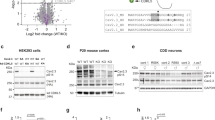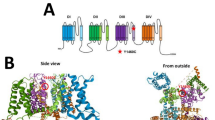Abstract
Juvenile myoclonic epilepsy (JME) is the most frequent cause of hereditary grand mal seizures1,2. We previously mapped and narrowed a region associated with JME on chromosome 6p12–p11 (EJM1)3,4,5. Here, we describe a new gene in this region, EFHC1, which encodes a protein with an EF-hand motif. Mutation analyses identified five missense mutations in EFHC1 that cosegregated with epilepsy or EEG polyspike wave in affected members of six unrelated families with JME and did not occur in 382 control individuals. Overexpression of EFHC1 in mouse hippocampal primary culture neurons induced apoptosis that was significantly lowered by the mutations. Apoptosis was specifically suppressed by SNX-482, an antagonist of R-type voltage-dependent Ca2+ channel (Cav2.3). EFHC1 and Cav2.3 immunomaterials overlapped in mouse brain, and EFHC1 coimmunoprecipitated with the Cav2.3 C terminus. In patch-clamp analysis, EFHC1 specifically increased R-type Ca2+ currents that were reversed by the mutations associated with JME.
This is a preview of subscription content, access via your institution
Access options
Subscribe to this journal
Receive 12 print issues and online access
$209.00 per year
only $17.42 per issue
Buy this article
- Purchase on Springer Link
- Instant access to full article PDF
Prices may be subject to local taxes which are calculated during checkout






Similar content being viewed by others
References
Janz, D.C.W. Impusive-petit mal. J. Neurol. 176, 344–386 (1957).
Delgado-Escueta, A.V. et al. Mapping and positional cloning of common idiopathic generalized epilepsies: juvenile myoclonus epilepsy and childhood absence epilepsy. Adv. Neurol. 79, 351–374 (1999).
Liu, A.W. et al. Juvenile myoclonic epilepsy locus in chromosome 6p21.2-p11: linkage to convulsions and electroencephalography trait. Am. J. Hum. Genet. 57, 368–381 (1995).
Liu, A.W. et al. Juvenile myoclonic epilepsy in chromosome 6p12-p11: locus heterogeneity and recombinations. Am. J. Med. Genet. 63, 438–446 (1996).
Bai, D. et al. Juvenile myoclonic epilepsy: Linkage to chromosome 6p12 in Mexico families. Am. J. Med. Genet. 113, 268–274 (2002).
Sander, T. et al. Refined mapping of the epilepsy susceptibility locus EJM1 on chromosome 6. Neurology 49, 842–847 (1997).
Greenberg, D.A. et al. Reproducibility and complications in gene searches: linkage on chromosome 6, heterogeneity, association, and maternal inheritance in juvenile myoclonic epilepsy. Am. J. Hum. Genet. 66, 508–516 (2000).
Pal, D.K. et al. BRD2 (RING3) is a probable major susceptibility gene for common juvenile myoclonic epilepsy. Am. J. Hum. Genet. 73, 261–270 (2003).
Pinto, D. et al. Evidence for linkage between juvenile myoclonic epilepsy-related idiopathic generalized epilepsy and 6p11-12 in Dutch families. Epilepsia 45, 211–217 (2004).
Suzuki, T. et al. Identification and mutational analysis of candidate genes for juvenile myoclonic epilepsy on 6p11-p12: LRRC1, GCLC, KIAA0057 and CLIC5. Epilepsy Res. 50, 265–275 (2002).
Braunewell, K.H. & Gundelfinger, E.D. Intracellular neuronal calcium sensor proteins: a family of EF-hand calcium-binding proteins in search of a function. Cell Tissue Res. 295, 1–12 (1999).
Escayg, A. et al. Coding and noncoding variation of the human calcium-channel beta 4-subunit gene CACNB4 in patients with idiopathic generalized epilepsy and episodic ataxia. Am. J. Hum. Genet. 66, 1531–1539 (2000).
Jouvenceau, A. et al. Human epilepsy associated with dysfunction of the brain P/Q-type calcium channel. Lancet 358, 801–807 (2001).
Fletcher, C.F. et al. Absence epilepsy in tottering mutant mice is associated with calcium channel defects. Cell 87, 607–617 (1996).
Burgess, D.L., Jones, J.M., Meisler, M.H. & Noebels, J.L. Mutation of the Ca2+ channel beta subunit gene Cchb4 is associated with ataxia and seizures in the lethargic (lh) mouse. Cell 88, 385–392 (1997).
Letts, V.A. et al. The mouse stargazer gene encodes a neuronal Ca2+-channel gamma subunit. Nat. Genet. 19, 340–347 (1998).
Newcomb, R. et al. Selective peptide antagonist of the class E calcium channel from the venom of the tarantula Hysterocrates gigas. Biochemistry 37, 15353–15362 (1998).
Yokoyama, C.T. et al. Biochemical properties and subcellular distribution of the neuronal class E calcium channel alpha 1 subunit. J. Neurosci. 15, 6419–6432 (1995).
Wakamori, M. et al. Single tottering mutations responsible for the neuropathic phenotype of the P-type calcium channel. J. Biol. Chem. 273, 34857–34867 (1998).
Catterall, W.A. Structure and regulation of voltage-gated Ca2+ channels. Annu. Rev. Cell Dev. Biol. 16, 521–555 (2000).
Woermann, F.G., Sisosiya, S.M., Free, S.L. & Duncan, J.S. Quantitative MRI in patients with idiopathic generalized epilepsy - Evidence of widespread cerebral structural changes. Brain 121, 1661–1667 (1998).
Meencke, H.J. & Veith, G. The relevance of slight migrational disturbances (microdysgenesis) to the etiology of the epilepsies. in Jasper's Basic Mechanisms of the Epilepsies, 3rd Edition, Advances in Neurology vol. 79 (eds. Delgado-Escueta, A.V., Wilson, W.A., Olsen, R.W. and Porter, R.J.) 123–131 (Lippincott Williams and Wilkins, Philadelphia, 1999).
Saegusa, H. et al. Altered responses in mice lacking α1E subunit of the voltage-dependent Ca2+ channel. Proc. Natl. Acad. Sci. USA 97, 6132–6137 (2000).
Pennacchio, L.A. et al. Mutations in the gene encoding cystatin B in progressive myoclonus epilepsy (EPM1). Science 271, 1731–1734 (1996).
Virtaneva, K. et al. Unstable minisatellite expansion causing recessively inherited myoclonus epilepsy, EPM1. Nat. Genet. 15, 393–396 (1997).
Sugimoto, Y. et al. Childhood absence epilepsy in 8q24: refinement of candidate region and construction of physical map. Genomics 68, 264–272 (2000).
Morita, R. et al. Exclusion of the JRK/JH8 gene as a candidate for human childhood absence epilepsy mapped on 8q24. Epilepsy Res. 37, 151–158 (1999).
Niidome, T., Kim, M.S., Friedrich, T. & Mori, Y. Molecular cloning and characterization of a novel calcium channel from rabbit brain. FEBS Lett. 308, 7–13 (1992).
Chen, Y. et al. Formation of an endophilin-Ca2+ channel complex is critical for clathrin-mediated synaptic vesicle endocytosis. Cell 115, 37–48 (2003).
Acknowledgements
We thank the family members for participating in this study; Y. Itsukaichi, K. Yamada, Y. Tsutsumi, K. Shoda, E. Mazaki, A. Nitta, N. Okamura, C. Uchikawa, M. Hishinuma and S.G. Pietsch for their help; and the Research Resources Center of RIKEN Brain Science Institute for DNA sequencing analysis and generation of rabbit polyclonal antibodies. This work was supported in part by a grant from RIKEN Brain Science Institute, Japan. A.V.D.E. is partly supported by a grant from the US National Institutes of Health.
Author information
Authors and Affiliations
Corresponding authors
Ethics declarations
Competing interests
The authors declare no competing financial interests.
Supplementary information
Supplementary Fig. 1
Amino acid sequence of EFHC1 and evolutionary conservation of amino acids mutated in JME. (PDF 25 kb)
Supplementary Fig. 2
Expression of mouse Efhc1 transcripts and proteins. (PDF 500 kb)
Supplementary Fig. 3
No effect of VDCC antagonists on neurons expressing GFP-controls and binding of EFHC1 mutants to CaV2.3. (PDF 642 kb)
Supplementary Table 1
Modulation of activation and inactivation properties of CaV2.3 by EFH1 proteins. (PDF 397 kb)
Rights and permissions
About this article
Cite this article
Suzuki, T., Delgado-Escueta, A., Aguan, K. et al. Mutations in EFHC1 cause juvenile myoclonic epilepsy. Nat Genet 36, 842–849 (2004). https://doi.org/10.1038/ng1393
Received:
Accepted:
Published:
Issue Date:
DOI: https://doi.org/10.1038/ng1393
This article is cited by
-
Sex differences in the intergenerational link between maternal and neonatal whole blood DNA methylation: a genome-wide analysis in 2 birth cohorts
Clinical Epigenetics (2023)
-
Genetic Knockout of TRPM2 Increases Neuronal Excitability of Hippocampal Neurons by Inhibiting Kv7 Channel in Epilepsy
Molecular Neurobiology (2022)
-
Sodium, Potassium, Calcium, and Magnesium in the Scalp Hair and Blood Samples Related to the Clinical Stages of the Parkinson’s Disease
Biological Trace Element Research (2021)
-
Clinical and genetic study of Tunisian families with genetic generalized epilepsy: contribution of CACNA1H and MAST4 genes
neurogenetics (2018)
-
Genetic Variants Identified from Epilepsy of Unknown Etiology in Chinese Children by Targeted Exome Sequencing
Scientific Reports (2017)



